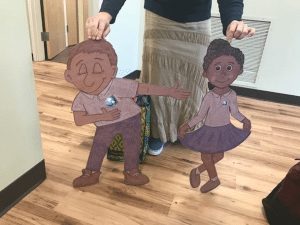Montessori Geometric Cabinet
Can a three-year-old really learn geometry? Absolutely–in fact, the early years are the perfect time for it. We have a special tool we use in teaching! We use the Montessori Geometric Cabinet to teach our students!
Preschool children are in a sensitive period for language and for order. They crave to know the names of things and have an innate desire to classify their knowledge. The Montessori Geometric Cabinet contains a set of two-dimensional shapes for children to explore.
The Montessori geometric cabinet is part of the Montessori sensorial curriculum. While the first two and a half to three years of life are all about gathering information through the senses, the next phase is about organizing it all.
If you thought geometry was math, you’re not quite wrong. Much of the sensorial curriculum sets the foundation for later math concepts.
The Montessori geometric cabinet is a visual sensorial material. Composed of a variety of two-dimensional shapes, its purpose is to isolate visual distinctions between forms. The forms vary in both either shape or size.
The Montessori Geometric Cabinet Includes:
- Circles of various diameters
- Square and rectangles of varying lengths
- Triangles:
- Equilateral
- Acute-angled isosceles
- Right-angled isosceles
- Obtuse-angled isosceles
- Right-angled scalene
- Obtuse-angled scalene
- Regular polygons:
- Pentagon
- Hexagon
- Heptagon
- Octagon
- Nonagon
- Decagon
- Quadrilaterals
- Rhombus
- Parallelogram
- Right-angled trapezoid
- Isosceles trapezoid
- Curved figures
- Curvilinear triangle
- Ellipse
- Oval
- Quatrefoil
- Demonstration tray to display three shapes at a time
Teaching with the Geometric Cabinet
From the Montessori geometric cabinet, lay out three shapes at a time on the demonstration tray. Use a three-period lesson to introduce their names.
For example:
This is a circle. This is a square. This is a triangle.
Next: Can you show me the square? Can you show me the triangle?
Next: What is this?
The three-period lesson lets the child gain mastery over the terms at their own pace. Whenever they mistake in their response, move back one step. If they cannot show you the square, point to it and move back to “this is a square.”
This is important: we show and name with the Montessori geometric cabinet. We do not define or explain. In other words, do not alert the child to the fact that a pentagon has five sides. That is the child’s mental work. We do not want to rob them of an opportunity to discover something for themselves.
Begin with three shapes that look very different from one another. A circle, triangle, and rectangle are a good start. Later, bring out shapes within the same categories. For example, pull out three curved figures, such as a circle, oval, and ellipse. Remember that the purpose of this material is to bring the child’s attention to the visual distinctions between flat shapes.
Don’t Wait To Start Using!
It is important to introduce the material from the Montessori geometric cabinet during the preschool years. Children at this age happily absorb vast amounts of language. Now is the time for vocabulary instruction. Trying to do the same lessons at a later age becomes tedious. Wait too long and you may find yourself needing to impose lessons on a child. This is not at all ideal.
The sensitive period for language is the time to teach terms and classification words. Not only do the children absorb it all effortlessly but it also makes a mark on their long term memory.
How Geometry Shapes the Brain
The Montessori geometric cabinet is not just school work. Working with these shapes brings them into our children’s consciousness and they will begin to notice them wherever the go. Bringing these shapes to the forefront actually shapes the brain to keenly observe visual details. This kind of mind is needed for careers such as architecture, engineering, and design.


